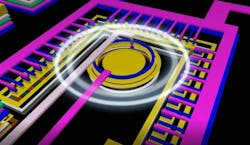On-chip optical link is created on electronic chip for the first time
Researchers of the University of Twente (UT; Enschede, Netherlands) have, for the first time, succeeded in connecting two parts of an electronic chip using an on-chip optical link, all fabricable with standard CMOS technology—a long-sought-after goal, as intrachip connection via light is almost instantaneous and also provides electrical isolation. Such a connection can, for example, be a safe way of connecting high-power electronics and digital control circuitry on a single chip without a direct electrical link. Vishal Agarwal, a UT PhD student, created a very small optocoupler circuit that delivers a data rate of megabits per second in an energy-efficient way.1
Such a device will allow the high-power portion of "smart power" chips to be isolated from the digital control circuits, guaranteeing safe operation in application areas like medical electronics and automotive. Conventionally, a bulky off-chip optocoupler is used for this. The new on-chip optocoupler can be integrated with the electronics, is about 0.008 mm2 in size, and consumes minimal energy.
The on-chip optocoupler needs to include a light source—typically very difficult to create in silicon. And a silicon LED on a chip would emit small amounts of IR light with low efficiency, while a silicon detector doesn't work well in the IR. This is not a good starting point at all for a good connection. Previous research, however, by UT PhD student Satadal Dutta, proved that better results can be obtained by connecting the silicon LED "the wrong way." This leads to an avalanche effect, resulting in the emission of visible light. In the same way, a light detector can be made at which a single photon can induce an avalanche. The result is an efficient optical connection.
The principle worked; next for Agarwal, the challenge was to design an electronic circuit to properly control the LED and the detector, optimizing for energy consumption, speed, and use of space on the chip. For example: what is the voltage needed for operating the avalanche-mode LED (AMLED) and the single-photon avalanche diode (SPAD) in the most efficient way, resulting in a good connection without wasting light? How to position the light source and light detector on the chip, for the highest efficiency?
The 1 Mbit/s data rate of the resulting optocoupler is already an acceptable rate for many applications; however, according to Agarwal, this rate can be increased at least tenfold.
Source: https://www.utwente.nl/en/news/!/2019/1/96361/light-connects-two-worlds-on-a-single-chip
REFERENCE:
1. Dissertation, "Optocoupling in CMOS," by Vishal Agarwal; DOI 10.3990/1.9789036547079.
About the Author
John Wallace
Senior Technical Editor (1998-2022)
John Wallace was with Laser Focus World for nearly 25 years, retiring in late June 2022. He obtained a bachelor's degree in mechanical engineering and physics at Rutgers University and a master's in optical engineering at the University of Rochester. Before becoming an editor, John worked as an engineer at RCA, Exxon, Eastman Kodak, and GCA Corporation.

